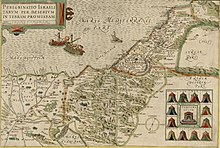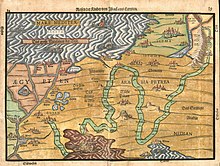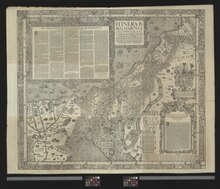This is an old revision of this page, as edited by Onceinawhile (talk | contribs) at 22:53, 26 December 2019 (+map). The present address (URL) is a permanent link to this revision, which may differ significantly from the current revision.
Revision as of 22:53, 26 December 2019 by Onceinawhile (talk | contribs) (+map)(diff) ← Previous revision | Latest revision (diff) | Newer revision → (diff)


The Stations of the Exodus are the 42 locations visited by the Israelites following their exodus from Egypt, recorded in Numbers 33, with variations also recorded in the books of Exodus and Deuteronomy.
According to the documentary hypothesis, the list of the Stations is believed to have originally been a distinct and separate source text. In this hypothesis, it is believed that the redactor, in combining the Torah's sources, used parts of the Stations list to fill out awkward joins between the main sources. The list records the locations visited by the Israelites, during their journey through the wilderness, after having left Egypt. Consequently, the parts which were inserted to join up the sources appear in suitable locations in the books of Exodus and Numbers.
However, a slightly variant version of the list appears in full at Numbers 33, and several parts of the journey described in the full list, most noticeably the journey from Sinai to Zin, do not appear in the fragmented version.
Both versions of the list contain several brief narrative fragments. For example " ... and they came to Elim, where there were twelve wells of water, and seventy date-palms...". It is a matter of some debate as to how much of the narrative is part of the original text of the list, and how much is extra detail added into it by the redactor.
The situation also occurs in reverse, where some brief texts, within parts of the list, and ascribed to the redactor, are usually regarded as not being part of the list of stations, albeit without much conviction. This is particularly true for Numbers 21:14–15, which references unknown events in the lost Book of the Wars of the Lord, and Numbers 21:16b–18a, describing the digging of the well at Beer.
Biblical commentators like St Jerome in his Epistle to Fabiola, Bede (Letter to Acca: "De Mansionibus Filiorum Israhel") and St Peter Damian discussed the Stations according to the Hebrew meanings of their names. Dante modeled the 42 chapters of his Vita Nuova on them.
List of the Stations of the Exodus
| Station | Biblical reference | Description | Modern location |
| Raamses | Ex. 12:37; Nu. 33:3,5 | The Raamses district was of the highest quality land in Egypt (Ge. 47:11) | uncertain although it has been argued that it was Pi-Ramesses |
| Sukkoth | Ex. 12:37, 13:20; Nu. 33:5-6 | An Egyptian city near the border | Tjeku (Zuko), Tell el-Maskhuta (Pithom) |
| Etham | Ex. 13:20; Nu. 33:6-8 | "On the edge of the wilderness" | Ismailia? |
| Pi-Hahiroth | Ex. 14:2-3; Nu. 33:7-8 | Lit. Mouth of the Gorges, "between Migdol and the sea, opposite Ba'al-Zephon" (possibly "the Bay of Hiroth") | Prob. a channel opening into one of the Bitter Lakes or the Mediterranean- Pi-hahiroth was located near the Red Sea. |
| Marah | Ex. 15:23; Nu. 33:8-9 | Lit. 'bitterness' | 30 kilometres north of As Suways (the port of Suez)? |
| Elim | Ex. 15:27, 16:1; Nu. 33:9-10 | Had 12 wells and 70 palm trees | ? |
| By the Red Sea | Nu. 33:10-11 | - - | Near Gulf of Suez |
| Sin Wilderness | Ex. 16:1, 17:1; Nu. 33:11-12 | God supplies quail and manna, "Between Elim and Sinai" | |
| Dophkah | Nu. 33:12-13 | - - | - - |
| Alush | Nu. 33:13-14 | - - | - - |
| Rephidim | Ex. 17:1, 19:2; Nu. 33:14-15 | God commands Moses to strike a "Rock of Horeb", water gushes forth to alleviate thirst. | ? |
| Sinai Wilderness | Ex. 19:1-2; Nu. 10:12, 33:15-16 | Near Mount Sinai | |
| Kibroth-Hattaavah | Nu. 11:35, 33:16-17 | Lit. Graves of Longing or Graves of Lust | - - |
| Hazeroth | Nu. 11:35, 12:16, 33:17-18 | - - | - - |
| Rithmah | Nu. 33:18-19 | - - | - - |
| Rimmon-Perez | Nu. 33:19-20 | - - | - - |
| Libnah | Nu. 33:20-21 | - - | - - |
| Rissah | Nu. 33:21-22 | - - | - - |
| Kehelathah | Nu. 33:22-23 | - - | - - |
| Mount Shapher | Nu. 33:23-24 | - - | - - |
| Haradah | Nu. 33:24-25 | - - | - - |
| Makheloth | Nu. 33:25-26 | - - | - - |
| Tahath | Nu. 33:26-27 | - - | - - |
| Tarah | Nu. 33:27-28 | - - | - - |
| Mithcah | Nu. 33:28-29 | - - | - - |
| Hashmonah | Nu. 33:29-30 | - - | - - |
| Moseroth | Nu. 33:30-31 | - - | - - |
| Bene-Jaakan | Nu. 33:31-32 | - - | - - |
| Hor Haggidgad | Nu. 33:32-33 | - - | - - |
| Jotbathah | Nu. 33:33-34 | - - | - - |
| Abronah | Nu. 33:34-35 | - - | - - |
| Ezion-Geber | Nu. 33:35-36 | - - | Near northern tip of Gulf of Aqaba |
| Kadesh | Nu. 20:1,22, 33:36-37 | Located in the Wilderness of Zin; Miriam's burial place | Probably Ain el Qadeis |
| Mount Hor | Nu. 20:22, 21:4, 33:37-41 | On the Edomite border; Aaron's burial place | - - |
| Zalmonah | Nu. 33:41-42 | - - | - - |
| Punon | Nu. 33:42-43 | - - | - - |
| Oboth | Nu. 21:10-11, 33:43-44 | - - | - - |
| Abarim Ruins | Nu. 21:11, 33:44-45 | - - | - - |
| Dibon Gad | Nu. 33:45-46 | - - | - - |
| Almon Diblathaim | Nu. 33:46-47 | - - | - - |
| Abarim Mountains | Nu. 33:47-48 | Israelites encamped beneath Mount Nebo | - - |
| Moab Plains | Nu. 22:1, 33:48-50 | Israelites encamped on the Jordan River from Beith Hayishimoth to Aveil Hashittim | Occupied most of the Trans-Jordan region |
References
- Nili S. Fox, in Adele Berlin, Marc Zvi Brettler (editors), The Jewish study Bible, Jewish Publication Society TANAKH Translation, Oxford University Press, Oxford (1999), p. 349: "The literary style of the itinerary, the repetition of campsite names, and the highlighting of events in those places closely resemble extant military records from the ancient Near East, especially from Assyria. Accordingly, the notation in this Priestly source that Moses recorded the starting points of their various marches (v. 2) fits the genre. Some scholars, however, consider ch 33 a composite text extracted from other portions of Numbers, Exodus, and Deuteronomy."
- Gregory F. LaNave, et al., The Fathers of the Church: Mediaeval Continuation, The Letters of Peter Damian 151-180, Letter 160, pp. 110 ff., The Catholic University of America Press, Washington D.C. (2005)
- Julia Bolton Holloway, Sweet New Style: Brunetto Latino, Dante Alighieri and Geoffrey Chaucer, Chapter III, (2003)